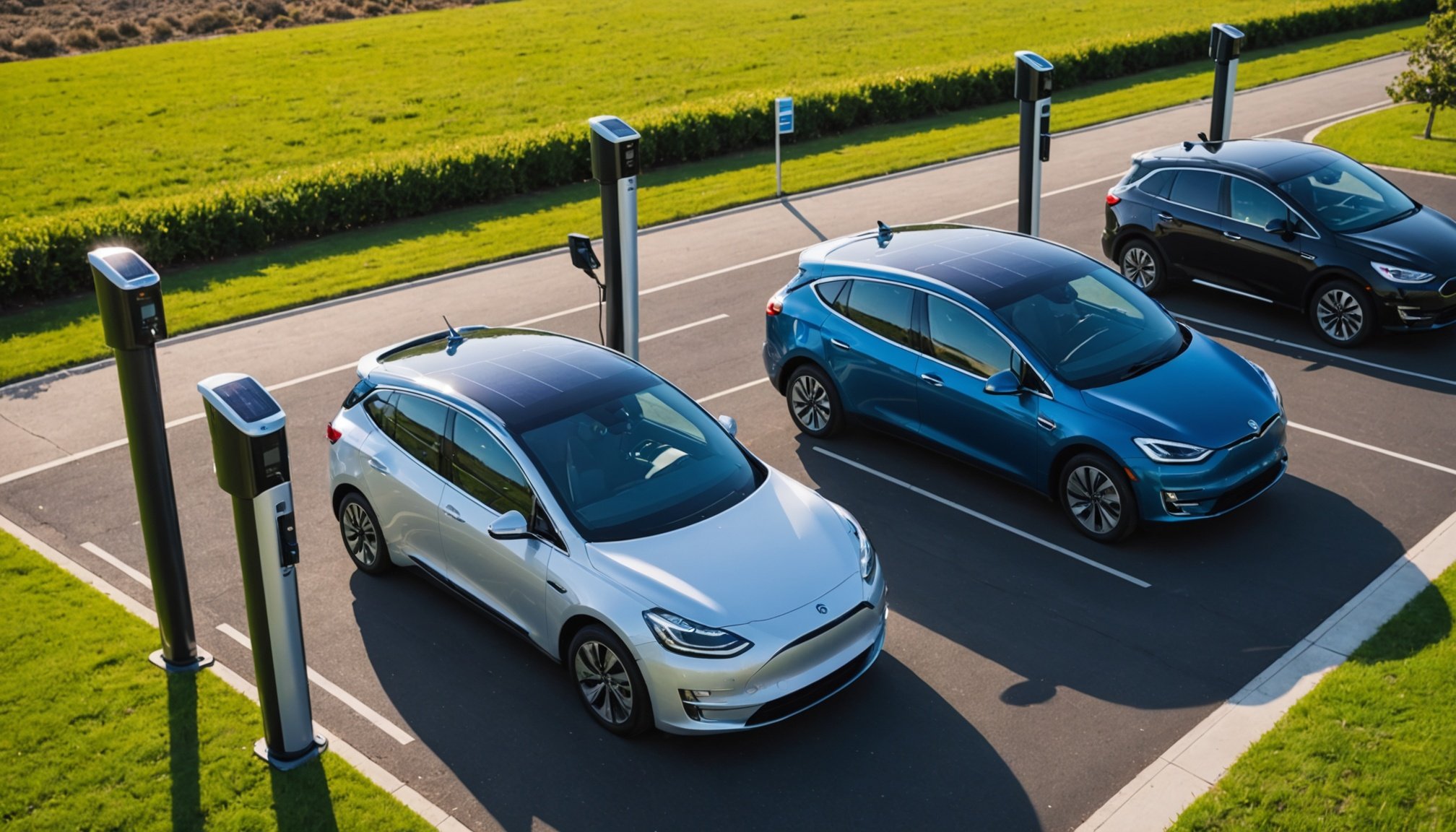Overview of Solar Charging Stations
Solar Charging Stations are a pivotal innovation in the world of electric vehicle (EV) charging. They harness the sun’s energy to provide a renewable and sustainable power source for EVs. But how exactly do these stations operate? Solar panels capture sunlight, converting it into electricity through photovoltaic cells. This energy is then stored in batteries or sent directly to the EV, allowing for a direct transfer of solar power to the vehicle.
The significance of solar energy within the electric vehicle ecosystem is profound. It offers a clean, green alternative to fossil fuels, which dominate traditional vehicle fueling methods. Solar energy reduces reliance on the electrical grid, which is crucial during high-demand periods.
In the same genre : Harnessing AI: Revolutionizing Predictive Maintenance Benefits in the UK Energy Industry
Furthermore, solar charging stations play a vital role in supporting EV infrastructure, promoting wider adoption by addressing concerns of charging speed and efficiency. As the technology progresses, solar charging stations are expected to become even more efficient and user-friendly, potentially making EV charging more accessible and economical for users globally.
Benefits of Using Solar Charging Stations
Solar Charging Stations offer significant benefits to electric vehicle (EV) owners. One of the most notable advantages is the potential for cost savings on electricity and maintenance. By utilising the sun’s renewable energy, EV owners can reduce reliance on traditional electrical sources, resulting in lower electricity bills. Additionally, solar energy systems typically require less maintenance compared to conventional power sources, further reducing overall costs.
Also read : Unpacking Brexit’s Effects on UK Agriculture: Navigating Challenges and Seizing Opportunities
Another important benefit is the reduced carbon footprint. Solar charging provides a cleaner energy alternative, which is crucial for environmentally-conscious consumers looking to minimise their impact on the planet. This transition contributes positively to the fight against climate change and supports global sustainability efforts.
Independence from the grid adds an extra layer of convenience. EV owners can charge their vehicles without depending on local electricity supplies, which is particularly beneficial during power outages or peak demand periods. This independence enhances the accessibility of charging for those in remote areas or places with an unreliable electricity supply. Thus, solar charging stations not only offer financial and environmental advantages but also improve the overall quality and convenience of EV ownership.
Comparing Solar Charging to Traditional Charging Methods
Solar vs Traditional Charging is an ever-evolving topic, as both methods have their nuances. When assessing charging efficiency, solar charging holds its own by offering free energy sourced from the sun. This feature makes it a cost-effective option in the long run, despite its initial setup costs. In contrast, traditional grid charging can incur higher costs due to ongoing electricity expenses.
The speed of charging is another point of differentiation. Traditional charging stations, especially fast chargers, tend to provide quicker charging times compared to solar. However, for those prioritising sustainability and cost savings, solar charging‘s slower pace might be a worthwhile trade-off.
Considering grid stability, solar charging stations shine during peak demand periods as they reduce strain on the electricity grid. This not only benefits the environment but also enhances stability for other users. Moreover, solar solutions can contribute to energy independence, providing reliability even during grid failures.
Long-term financial implications favour solar charging for its ability to diminish electricity bills over time, reinforcing the financial viability and sustainability of EV ownership.
Installation Options for Solar Charging Stations
Solar Charging Station Installation is an exciting area for electric vehicle owners looking for sustainability. Multiple configurations exist to cater to different needs. Homeowners often opt for rooftop panels linked to their home charging solutions, offering a seamless blend of utility and convenience. Commercial setups, on the other hand, might feature larger arrays, sometimes integrated within parking lots. This versatility highlights solar’s adaptability.
When evaluating installation costs, various factors come into play. The size of the system affects costs directly: larger setups naturally incur higher expenses. Local solar incentives can significantly impact the financial outlay, lowering the upfront investment. Nevertheless, professional installation, a key step, influences costs as well.
Selecting a suitable location hinges on sunlight availability. Ideal spots receive ample direct sunlight throughout the day, unimpeded by shade or nearby structures. This ensures the system operates at maximum efficiency, directly powering EV charging needs. By assessing these elements carefully, prospective users can make informed decisions, ensuring they leverage solar energy effectively for their electric vehicles.
Government Incentives and Financial Considerations
Solar Charging Station incentives can significantly impact the financial feasibility for those considering installation. Recognising the importance of promoting clean energy, many governments offer a variety of incentives to encourage the adoption of solar charging solutions. These solar incentives often include tax credits and rebates, which reduce the overall costs of installation, providing financial relief to EV owners. For instance, specific tax incentives might cover a percentage of the installation cost, making solar charging more accessible.
Electric Vehicle Tax Credits also play a vital role. Offered to buyers of electric vehicles, these credits can make EV ownership more appealing. By reducing the purchase cost of the vehicle, they indirectly enhance the attractiveness of investing in solar charging stations, as the combined savings strengthen the economic argument for going green.
Moreover, exploring various financing options further optimises the return on investment (ROI) for consumers. Loans, leases, or power purchase agreements can be tailored to suit individual circumstances, paving the way for a smoother transition to solar energy. These financial strategies are crucial in mitigating upfront costs and accelerating the widespread adoption of sustainable practices.
Real-World Case Studies and User Testimonials
Solar Charging Experience can be best understood through real-world examples. Many early adopters have highlighted how solar charging stations have transformed their daily routines. EV Owner Stories often convey significant savings in electricity bills and a noticeable drop in carbon emissions, showcasing both financial and environmental benefits.
A standout example is from a coastal town where residents collectively invested in a community solar charging hub. Users reported reduced dependency on the grid, even during tourist season peaks, demonstrating solar’s reliability. One user expressed, “Solar has not only saved costs but also provided energy security amidst fluctuating local supply.”
Testimonials frequently point to the convenience of charging at home via these stations. Analysis of case studies shows remarkable efficiency, with some owners noting a 20-30% reduction in annual charging expenses compared to conventional methods. These examples of daily benefits echo the technological advances’ promise, ensuring that solar solutions remain an appealing choice for future electric vehicle owners.
In essence, these narratives paint a promising picture of solar charging’s integration into everyday life, reinforcing the decision for many to shift towards a more sustainable future.
Future Trends in Solar Charging Technology
The future of solar charging technology is gearing up for transformational breakthroughs, promising enhanced convenience and efficiency for electric vehicle (EV) users. Key advancements lie in emerging technologies aimed at improving the efficiency and integration of solar charging systems. Innovations like bifacial solar panels and improved photovoltaic cell efficiencies are anticipated to significantly increase energy capture, making charging stations more productive and cost-effective.
Predictions for the solar charging market posit a robust growth trajectory, closely tied to the expanding EV domain. As adoption of EVs accelerates, demand for solar charging infrastructure is expected to rise, necessitating widespread implementation of smart charging grids. This infrastructure will play a pivotal role in seamlessly merging renewable energy sources with urban planning.
Moreover, developments in smart grid technologies will facilitate intelligent energy distribution, allowing EV owners to leverage real-time data for optimal charging periods. This ensures that solar charging solutions can operate effectively within existing urban landscapes, providing necessary flexibility for future expansion. By embracing these innovations, the solar charging industry is poised to support sustainable transportation solutions for years to come.









